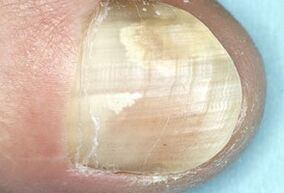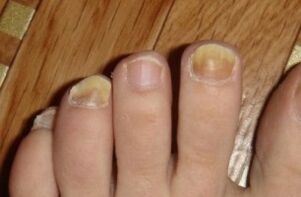
The fungus of the toes of the toes (onychomycosis of the legs) is an infectious disease manifested in damage to the nails of dermatomycetes, mold or fungi, similar to yeast.According to statistics, the spread of this disease in the population reaches 10%.
The risk of infection with onychomycosis of the legs directly depends on the social and climatic conditions of a person's stay, his gender, age, profession and presence or absence of other diseases.
In one way or another, due to its high infections and the ability to significantly impair the quality of the patient's daily routine, this pathology requires timely detection and competent, overall treatment.
Symptoms of nail fungus
Depending on the symptomatic manifestations, there are three types of onychomycosis of the legs:
- hypertrophic;
- normotrophic;
- Atrophic.
Hypertrophic nail damage is characterized by noticeable thickening and nail deformation, loss of shine and the appearance of "corrosion" at their edges.The clinical picture of the disease can be supplemented by the onset of pain and the development of onychgrifosis (pathology in which nails acquire the appearance of bird nails).
With onychomycosis of the normotrophic type, yellow or white stripes and spots appear on the nails.At the same time, the nails retain their configuration, shine and thickness.With atrophic onychomycosis, the nails are quickly separated from the nail, turns dull and turns gray-brown.The exposed area of the skin is covered with loose hyperkeratotic layers.
The clinical signs of nail fungus are at the heart of another classification of onychomycosis used mainly by foreign doctors.Based on this typology, 4 forms of the disease can be distinguished:
- distal (damage to the free edge of the nail);
- proximal (damage to the back folding of the nails);
- lateral (damage to the nail from the sides);
- Total (damage to the whole new plate).
The severity of the manifestations of onychomycosis should be taken into account when preparing a therapeutic program.
Treatment of nail fungus

The diagnosis of "onychomycosis of the legs" is made on the basis of the results of a visual medical examination, PCR test, microscopic and cultural tests.The above tests allows us to get a conclusion not only about the presence of a fungal infection, but also for the type of pathogen.
Now a few words about how to cure nail fungus at the shortest possible time.The onychomycosis ethitrop treatment program involves the use of topical and systemic drugs.The most effective remedy for topical fungus treatment on nail plates are:
- antifungal keratolytic ointments, gels and creams;
- specialized plasters for mechanical removal of the affected nails;
- Antifungal lacquers based on cyclopirox, amonolphin or mixtures of salicylic, benzoic, lactic acids and resorcinol.
Nowadays, systemic nail fungus therapy seems to be the most appropriate.In recent years, a number of common antifungal drugs have been developed that can increase the effectiveness of onychomycosis by up to 90%.
Nail fungus medicines
Larns are considered to be the most effective antifungal varnishes.The main distinguishing feature of the products is their ability to destroy pathogens in the deep layers of the nail and to penetrate the bed of the nails.Antifungal creams and ointments include products containing terbinafine.The listed products are applied daily to the affected nails and slightly rubbed until they are completely absorbed.The duration of treatment of onychomycosis with ointments and creams can vary between 2-6 weeks.The procedure for using local antifungal agents should be agreed early with a dermatologist.
The choice of systemic drugs is carried out taking into account the severity of the disease and the presence or absence of contraindications for their use in the patient.
Nail fungus prevention
The main measures aimed at preventing the development of onychomycosis of the legs are:
- avoiding mechanical nail trauma;
- refusing to wear rough, tight and poorly fitted shoes;
- Careful processing of pedicure tools;
- use of individual shoes when visiting baths, saunas and pools;
- monitoring of the healthy status of pets, timely treatment of identified pathologies;
- without the use of toiletries, clothes, towels and shoes belonging to other people;
- timely detection and treatment of diseases;
- Performing activities aimed at strengthening the body's immune forces.
It is important to understand that the self -medication of onychomycosis often not only fails to achieve the expected results, but also significantly complicates the course of the disease.Therefore, before using medicines or folk remedies, you should coordinate the treatment program with an experienced dermatologist.























